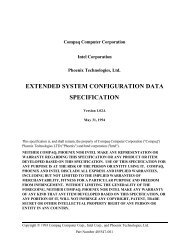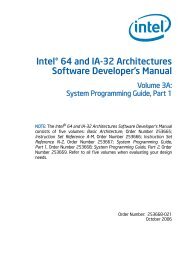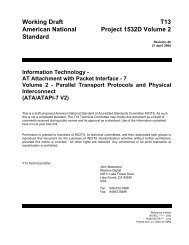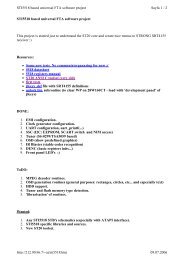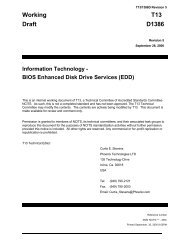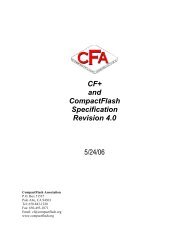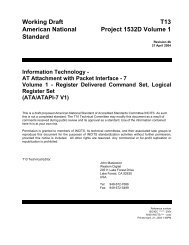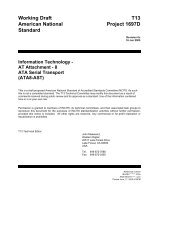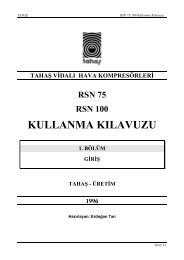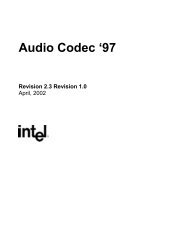Intel 64 and IA-32 Architectures Software Developer's Manual
Intel 64 and IA-32 Architectures Software Developer's Manual
Intel 64 and IA-32 Architectures Software Developer's Manual
You also want an ePaper? Increase the reach of your titles
YUMPU automatically turns print PDFs into web optimized ePapers that Google loves.
Documentation Changes<br />
OSXMMEXCPT<br />
Operating System Support for Unmasked SIMD Floating-Point Exceptions<br />
(bit 10 of CR4) — When set, indicates that the operating system supports<br />
the h<strong>and</strong>ling of unmasked SIMD floating-point exceptions through an exception<br />
h<strong>and</strong>ler that is invoked when a SIMD floating-point exception (#XF) is generated.<br />
SIMD floating-point exceptions are only generated by SSE/SSE2/SSE3<br />
SIMD floating-point instructions.<br />
The operating system or executive must explicitly set this flag. If this flag is not<br />
set, the processor will generate an invalid opcode exception (#UD) whenever it<br />
detects an unmasked SIMD floating-point exception.<br />
XMXE<br />
VMX-Enable Bit (bit 13 of CR4) — Enables VMX operation when set. See<br />
Chapter 19, “Introduction to Virtual-Machine Extensions.”<br />
TPLTask Priority Level (bit 3:0 of CR8) — This sets the threshold value corresponding<br />
to the highest-priority interrupt to be blocked. A value of 0 means all interrupts are<br />
enabled. This field is available in <strong>64</strong>-bit mode. A value of 15 means all interrupts will be<br />
disabled.<br />
25. VMXON opcode corrected<br />
In Chapter 5, “VMXON—Enter VMX Operation”, of the <strong>Intel</strong> ® <strong>64</strong> <strong>and</strong> <strong>IA</strong>-<strong>32</strong> <strong>Architectures</strong><br />
<strong>Software</strong> Developer’s <strong>Manual</strong>, Volume 2B, the summary chart has been corrected to<br />
address a typo. See below.<br />
-------------------------------------------------------------------<br />
VMXON—Enter VMX Operation<br />
Opcode Instruction Description<br />
F3 0F C7 /6 VMXON m<strong>64</strong> Enter VMX root operation.<br />
.. ... ....Text omitted here... ... ....<br />
26. MSR references updated<br />
In Sections 20.6.1 <strong>and</strong> 20.6.2 of the <strong>Intel</strong> ® <strong>64</strong> <strong>and</strong> <strong>IA</strong>-<strong>32</strong> <strong>Architectures</strong> <strong>Software</strong><br />
Developer’s <strong>Manual</strong>, Volume 3B, two MSR references (<strong>IA</strong><strong>32</strong>_VMX_PINBASED_CTLS,<br />
<strong>IA</strong><strong>32</strong>_VMX_PROCBASED_CTLS) have been corrected. The text is reprinted below to<br />
show context. See the change bars.<br />
-------------------------------------------------------------------<br />
20.6.1 Pin-Based VM-Execution Controls<br />
The pin-based VM-execution controls constitute a <strong>32</strong>-bit vector that governs the<br />
h<strong>and</strong>ling of asynchronous events (for example: interrupts). 1 Table 20-5 lists the controls<br />
supported. See Chapter 21 for how these controls affect processor behavior in VMX nonroot<br />
operation.<br />
1. Some asynchronous events cause VM exits regardless of the settings of the pin-based VM-execution controls<br />
(see Section 21.2).<br />
42 <strong>Intel</strong> ® <strong>64</strong> <strong>and</strong> <strong>IA</strong>-<strong>32</strong> <strong>Architectures</strong> <strong>Software</strong> Developer’s <strong>Manual</strong> Documentation Changes




